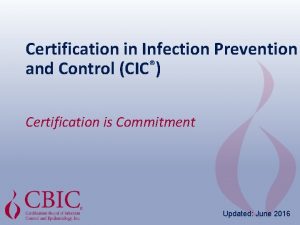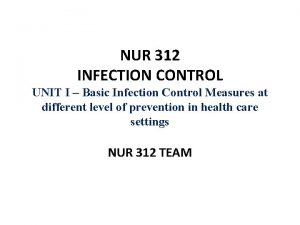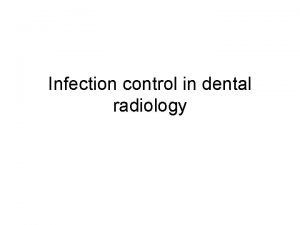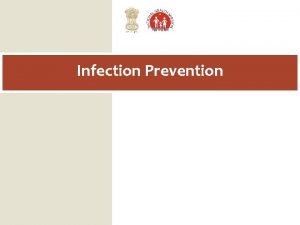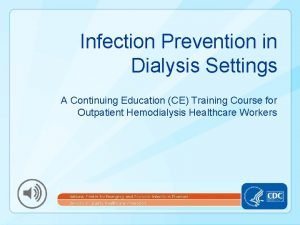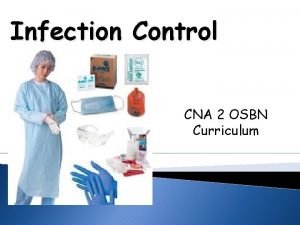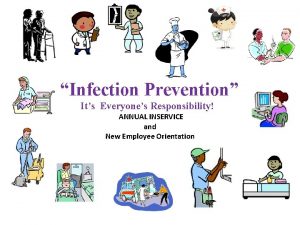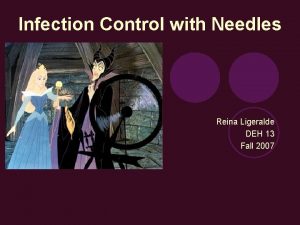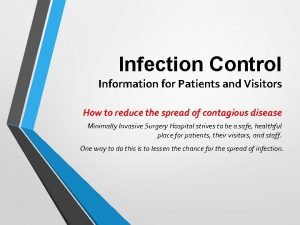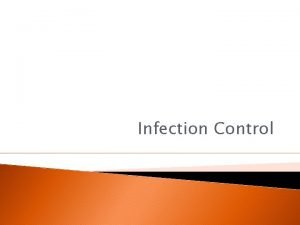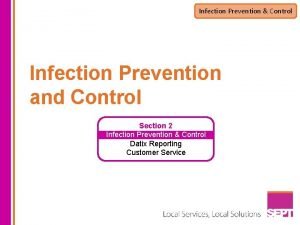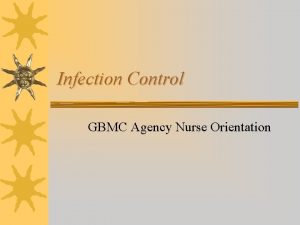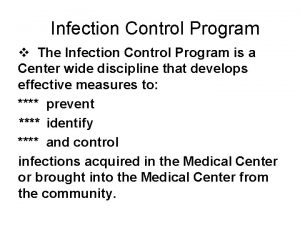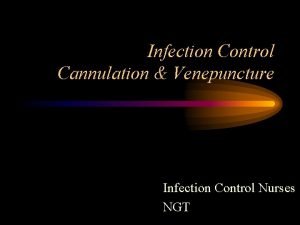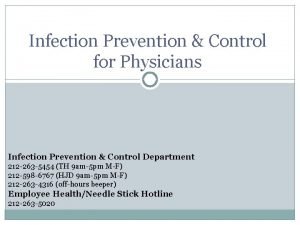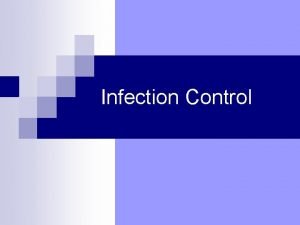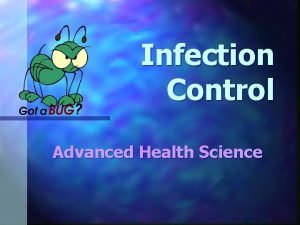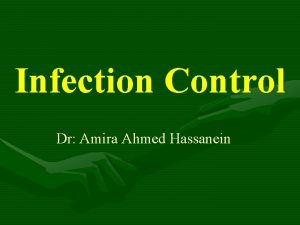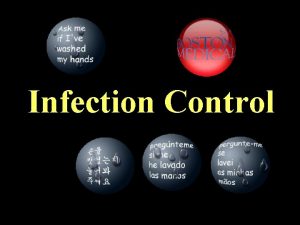Module 11 Infection Control MODULE PROFILE This module
















- Slides: 16

Module 11 Infection Control

MODULE PROFILE This module will help you: • Understand effective hand hygiene practices • Describe precautions • Be aware of health care workers’ vaccination needs • Know appropriate response following occupational exposure to body fluids

HAND HYGIENE • Hands are the most common way infection is spread in aged care facilities Routine hand washing technique 1. Wet hands with water 2. Apply metered amount of p. H-neutral liquid hand wash 3. Rub vigorously over all surfaces up to forearms for min 10– 15 secs 4. Rub between fingers, fingertips, thumbs & wrists 5. Rinse well with warm running water 6. Pat hands dry with paper towel & discard in bin

CHAIN OF INFECTION Infectious agent Microorganism with ability to cause disease eg, bacteria, virus, fungi, parasites. Reservoir Susceptible host Place within which microorganisms can thrive & reproduce Person who can’t resist microorganism invading their body, multiplying & resulting in infection eg, babies, pregnant women, elderly, immunosuppressed Portal of exit Portal of entry Any opening that allows a microorganism to enter eg, body orifices, mucous membranes, breaks in skin Provides a way for a microorganism to leave the reservoir eg, nose, mouth, faeces Mode of transmission eg, health care workers’ hands may carry bacteria from one person to another

STANDARD PRECAUTIONS Minimum routine practices may include: • • • Hand hygiene Personal protective equipment Use of aseptic technique - ‘clean technique’ to reduce infectious agents - when doing simple wound care wash hands thoroughly & frequently, wear appropriate protective apparel & use a non-touch technique • • Safe management of laundry & linen • Safe handling & disposal of clinical & general waste & sharps Appropriate reprocessing of used instruments & equipment

PERSONAL PROTECTIVE EQUIPMENT Includes: • Gloves • Masks / face shields • Protective eyewear • Aprons • Gowns Use • Apply before resident contact • Apply & remove carefully so as not to spread contamination • Remove & discard in appropriate skips • Immediately perform hand hygiene

EQUIPMENT & LINEN • Ensure re-usable equipment is appropriately cleaned & reprocessed BEFORE use for another resident • Discard single-use items properly • Place linen that’s wet or heavily soiled with body fluids in impermeable bag & tie securely • Do not rinse or sort linen in resident care areas • Tie off all linen bags securely when 2/3 – 3/4 full

HANDLING WASTE Waste should be segregated at point of generation into: 1. General incl. recyclable 2. Clinical (medical) • Any used sharp object • Visibly blood stained • Containers of body substance • Human tissue / lab specimens • Any other material classified by Infection Control or OH&S at your facility 3. Cytotoxic

SHARPS HANDLING • Dispose in sharps bin at point of use • Never pass by hand to another person • Do not re-cap needles or other sharps • Never bend or break needles • Dispose of needles & syringes as one unit

POTENTIAL TRANSFER Infection transfer could be: • Contact eg, infections like MRSA, scabies, shingles • Droplet eg, influenza, whooping cough • Airborne eg, pulmonary tuberculosis, influenza

ADDITIONAL PRECAUTIONS One or a combination. For eg: • Use of single room with ensuite • Appropriately worn personal protective equipment • Room sharing by residents with same infection • More frequent / thorough room cleaning • Negative air pressure (discharged directly outside) for airborne • Dedicating equipment for use with particular resident • Door sign asking people to consult nursing staff before entering • Consideration of staff immunity

WORKERS’ VACCINES May include: • Hepatitis A if working in rural indigenous communities • Hepatitis B for all patient care workers • Influenza for nursing home & long term care facility workers • Tuberculosis (check with State / Territory TB authorities) • Rubella for workers born during or since 1966 • Varicella zoster / chicken pox for workers not immune who have direct patient contact INFECTION CONTROL 0312 13

BODY FLUID EXPOSURE If exposed to resident blood 1. Wash needlestick injury / cuts with soap & water 2. If eyes affected, flush with water or saline 3. Flush any splashes to nose, mouth or skin with water 4. Do not squeeze area or use irritant chemical such as antiseptics 5. Immediately report exposure to person managing exposures in your facility

MANAGING BODY FLUID SPILLS Wear • General purpose household gloves • Protective eyewear to protect from splashes • Plastic apron to protect clothing from contamination Decontaminate • Non-porous surfaces • Carpet

SUMMARY • Hands are the most common way of spreading infection • Chain of infection: Mode of transmission, portal of entry / exit, susceptible host, infectious agent, reservoir • Personal protective equipment • Well managed equipment & linen • Safe handling of waste • Workers’ vaccination • Body fluid exposure

This certifies that Name: has attended the continence management session Module 11: Infection Control Date of Completion________________
 Dental radiographic interpretation ppt
Dental radiographic interpretation ppt State regulatory agencies milady
State regulatory agencies milady Chapter 16 infection control and standard precautions
Chapter 16 infection control and standard precautions Chapter 16 infection control and standard precautions
Chapter 16 infection control and standard precautions Chapter 15:3 washing hands
Chapter 15:3 washing hands Chapter 15:5 sterilizing with an autoclave
Chapter 15:5 sterilizing with an autoclave Certification in infection control cic
Certification in infection control cic Infection control meaning
Infection control meaning Infection control in dental radiology
Infection control in dental radiology Learning objectives for infection control
Learning objectives for infection control Conclusion of infection
Conclusion of infection Neutropenic precautions
Neutropenic precautions Certification board of infection control and epidemiology
Certification board of infection control and epidemiology Infection control is everyone's responsibility
Infection control is everyone's responsibility Infection control
Infection control Nsw health
Nsw health Infection control information
Infection control information






